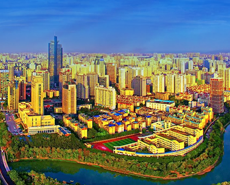
China to see steady recovery in copper consumption in H2
----Interview with Renfei Shi
General Manager
Shenzhen Sinoking Technology Co., Ltd.
General Manager
Shenzhen Sinoking Technology Co., Ltd.
Shenzhen Sinoking Technology Co., Ltd. was founded in July 2017 with a registered capital of 50 million yuan (7.72 million US dollars). It is a comprehensive service provider engaging in the trading of nonferrous metals such as copper, aluminum, lead and zinc, trade financing, imports of mineral products and so on. The company's operating revenue topped 10 billion yuan (1.5 billion US dollars) in 2020, including copper sales revenue of nearly 6 billion yuan (925 million US dollars).
Asian Metal: Mr. Shi, thank you very much for accepting our interview. Would you please first give us a brief introduction of your company?
Mr. Shi: Located in Futian District, Shenzhen Sinoking Technology Co., Ltd. is a comprehensive service provider engaging in the trading of commodities, including nonferrous metals like copper, aluminum, lead and zinc as well as mineral products. In 2020, our company provided specialized and quality professional services for industry giants such as Zijin Mining, Jiangxi Copper, Henan Jinli and Guangxi Jinsheng, with whom we established stable partnerships based on mutual trust. Copper is currently our most important business sector, which involves domestic trading of copper cathode, copper rod and so on, as well as the import of copper raw materials such as copper ore and blister copper.


Asian Metal: What is the business development plan for the company? Apart from trading, would the company consider investing in mines or copper entities?
Mr. Shi: In term of the future development plan, our domestic trading business has been relatively mature, and we would like to expand import business resources and channels by taking advantage of our shareholders' capital strength, while maintain our current businesses. We currently import copper concentrate and blister copper, and we may also consider importing copper cathode and copper scrap in the future. For investment in mines, we show interest in a Philippines-based mining company which we have done business with, and when the pandemic winds down, we would arrange an on-site visit before making the final decision. About copper entities, we initially planned to build copper scrap processing plant in Southeast Asia, but the plan has been put on hold for the moment as China eased on standards for importing copper scrap starting November 1, 2020. But if there are right projects and when risks are controllable, we would still consider investing in overseas assets, especially ports, warehouses, mines and processing plants involved in commodity trading.
Asian Metal: Chinese copper market failed to show traditional peak-season performance in April-May period damped by the high copper price. Do you think the second of this year would see a strong recovery in copper consumption from domestic end users?
Mr. Shi: As copper price surged to a historic high of around RMB77,000/t (USD11,881/t) in April-May period, downstream copper processing plants became much less active in purchasing and most of them were mainly clearing their stocks, leading to the relatively weak consumption compared with previous years. However, after China released national copper reserves into the market, coupled with a modest shift in U.S. monetary policy, copper price retreated to RMB70,000/t (USD10,801/t) in mid-June when downstream consumers were obviously more active in purchasing, along with the decreasing social inventory of copper cathode. But given that copper price still stays at a relative high level and the spread of COVID-19 variants leads to uncertainties about the real economy, we believe the second half of 2021 would see a modest recovery in domestic copper consumption.
Asian Metal: TCs for copper rod are relatively low amid white-hot competition in the industry. What is your company's business model for trading copper rod and how do you make profits?
Mr. Shi: Given the transparency of competition, TCs for copper rod Ф8mm were once as low as RMB300-400/t (USD46.29-61.72/t) in southern China, nearing or even dropping below the production cost. Under the current market conditions, there are two things we, as traders, can do to break the bottleneck for TCs. One is that we adopt consigned processing mode, in which we cooperate with copper rod plants to do processing and at the same time purchase imported copper cathode with up-to-standard quality but relatively low price to enter the market with low-cost advantages. The other is that, for downstream consumers, we transfer pricing power to buyers and nest supply chain finance service to flexibly serve the market in order to gain operating profits.

















